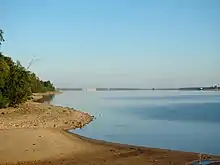Energy in Latvia
Latvia is a net energy importer. Primary energy use in Latvia was 49 TWh, or 22 TWh per million persons in 2009.[1] In 2018, electricity consumption per capita was 3731 kWh.[2]
Latvia has adopted the EU target to produce 50% of its energy from renewable sources by 2030.[3]
Energy statistics
|
|
|
CO2 emissions: |
Energy plan
The 2021-30 plan set a target of reducing greenhouse gas emissions by 65% compared to 1990.[5] There is a target of being carbon neutral by 2050.
Fuel types
Natural Gas
From 1 January 2023 Latvia banned the import of natural gas from Russia. The replacement comes from connections to LNG terminals, the Klaipeda LNG terminal in Lithuania, and from 2024 the recently-opened Inkoo LNG terminal in Finland.[6]
JSC Conexus Baltic Grid is the natural gas transmission system operator in Latvia. International transmission pipelines are 577 km long, consisting of the Riga–Pahneva, Pleskava–Riga, Izborska–Inčukalns UGS, Riga–Inčukalns UGS I - line, Riga–Inčukalns UGS II - line, Vireši–Tallinn pipelines. The total length of regional transmission pipelines is 613 km.[7]
Latvia has underground gas storage facilities at the Inčukalns UGS, with a capacity of 4.47 billion m3.[8]
Natural gas companies include Latvijas Gāze.
Renewable energy

| Achievement | Year | Achievement | Year | Achievement | Year |
|---|---|---|---|---|---|
| 2% | 1992 | 4% | 2017 | 6% | not achieved[4] |
Renewable energy includes wind, solar, biomass and geothermal energy sources.
Almost half of the electricity used in the country is provided by renewable energy sources. The main renewable resource is hydroelectric power. Latvia has laws that regulate the building of power plants and plans to sell electricity at higher prices. This is a stimulus for investment, especially taking into consideration the fact that Latvia cannot offer big subsidies in order to attract investment. A production quota is approved for each renewable energy source every year.
The share of renewable energy in the gross final energy consumption in 2021 in Latvia was 42.1%, thanks to strong hydroelectric power.[9]
Wind power
In 2021 Latvia had just 66 MW of wind energy capacity, with no wind farms being built since 2012.[10]
In 2022 a wind farm is in the initial planing stage to be located in the Gulf of Riga, Latvia having rejected the idea of working with Estonia on a nearby project, the new plan is expected to supply 1 GW of clean wind energy, which would translate to 3 TWh (Terawatt-hours) of renewable energy.[11]
Solar power
2023 will see the first two solar parks being completed in Latvia.[12]
Biomass
Biomass provides over 10% of Latvia's electricity production capacity.
Hydro power
Hydro is an important power source in Latvia, Ķegums Hydroelectric Power Station is the oldest hydro power station in the country, built in 1940.
Electricity
It was agreed in 2018 that Estonia, Latvia and Lithuania would connect to the European Union's electricity system and desynchronize from the Russian BRELL power system. This is expected to be completed by February 2025.[13]
A back up plan, should Russia disconnect the Baltic states before 2025, would enable a connection to the European grid to be completed within 24 hours.[14]
See also
References
- IEA Key energy statistics 2010 Archived 2010-10-11 at the Wayback Machine Page: Country specific indicator numbers from page 48
- "Key World Energy Statistics 2020" (PDF). Belgische Petroleum Federatie. August 2020.
- "Latvia adopts climate and energy plan and long term strategy". 31 January 2020.
- "Energy consumption in Latvia". 2020.
- "Latvia's National Energy and Climate Plan 2021-2030". 2020.
- "Latvia: Natural gas to be supplied in full via LNG terminals". 6 January 2023.
- "Latvia's Gas Transmission System". Retrieved 4 August 2023.
- "Natural Gas Storage". Retrieved 4 August 2022.
- "Latvia – the best location to invest in smart renewable energy". 17 May 2022.
- "Latvia has a lot of wind energy potential – it's time to start using it". 4 May 2021.
- "MoU with Latvia for offshore wind farm". 11 March 2022.
- "First two solar parks in Latvia to be completed by the end of 2023". 25 April 2023.
- "Baltic countries strike deal to disconnect from Russian power grid earlier than expected". 3 August 2023.
- "The high-speed railway that's uncoupling the Baltic states from Russia and their Soviet past". 16 September 2023.

.svg.png.webp)